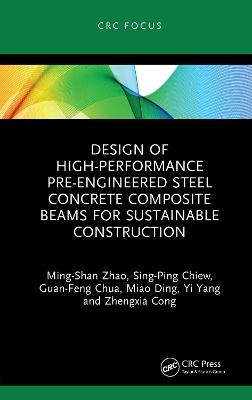
Design of High-performance Pre-engineered Steel Concrete Composite Beams for Sustainable Construction
CRC Press (Verlag)
978-1-032-62691-8 (ISBN)
This accessible and practical shortform book details the properties and advantages of high-performance pre-engineered steel-concrete composite beams (HPCBs) for improving the sustainability of construction techniques. It also explains the analysis methods for testing HPCB systems.
The authors describe a new HPCB system that has been developed to reduce the input of raw materials and embodied CO2 commonly associated with heavily loaded and long-spanned industrial buildings (which predominately comprise reinforced concrete) and improve the sustainability of the construction process. They provide several resources throughout to facilitate adoption by professionals.
Design equations derived from Eurocode 4 approach for ultimate limit state and serviceability limit state and worked examples are included throughout. The authors discuss the feasibility for both materials and the full-scale beams and CO2 reduction methods, including use of recycled concrete aggregate, ground granulated blast-furnace and silica fume to replace natural coarse
aggregates and Ordinary Portland Cement. Guidance for testing HPCBs—including setup, test procedure and data collection and interpretation—is also given. The authors also elaborate on recommendations for finite element analysis for HPCBs. Design examples are appended to illustrate typical current practice using a 12 × 12 m grid floor with live load of 15 kPa. Various considerations for different parameters such as fire resistance are discussed. Finally, the authors present a case study of a recently completed industrial building in Singapore to quantify the benefits of using HPCBs over reinforced concrete and conventional composite construction.
Structural engineering professionals, whose work relates to long-span and heavy-loading industrial or commercial buildings, will benefit from the detailed guidance and focus on practical applications provided throughout this book. Post-graduate students of advanced steel and composite structures will also benefit from these descriptions.
Ming-Shan Zhao is Assistant Professor of Civil Engineering at the Singapore Institute of Technology. Sing-Ping Chiew is Professor and Programme Leader of Civil Engineering at the Singapore Institute of Technology. Guan-Feng Chua is a Doctorate of Engineering candidate at the Singapore Institute of Technology. Miao Ding is a research engineer at the Singapore Institute of Technology. Yi Yang is a senior engineer at JTC Corporation, Singapore. Zhengxia Cong is Senior Director of Engineering (Building) at Woh Hup (Private) Limited, Professional Engineer in Civil Engineering and Special Professional Engineer in Geotechnical Engineering (Singapore), and Fellow of Charted Structural Engineer (UK).
Chapter 1 ◾ Introduction
Chapter 2 ◾ Materials and Buildability
Chapter 3 ◾ HPCB at Ultimate Limit State
Chapter 4 ◾ HPCB at Serviceability Limit State
Chapter 5 ◾ Validation of Analysis Methods with Measurements and Finite Element Analysis
Appendix A ◾ Worked Example: HPCB System for a 12 m × 12 m Grid Floor with Live Load of 20 kPa
Appendix B ◾ Case Study: Feasibility, Productivity, Cost and Carbon Analysis
| Erscheinungsdatum | 10.07.2024 |
|---|---|
| Zusatzinfo | 17 Tables, black and white; 53 Line drawings, black and white; 9 Halftones, black and white; 62 Illustrations, black and white |
| Verlagsort | London |
| Sprache | englisch |
| Maße | 138 x 216 mm |
| Gewicht | 290 g |
| Themenwelt | Naturwissenschaften ► Biologie ► Ökologie / Naturschutz |
| Technik ► Bauwesen | |
| Technik ► Umwelttechnik / Biotechnologie | |
| ISBN-10 | 1-032-62691-7 / 1032626917 |
| ISBN-13 | 978-1-032-62691-8 / 9781032626918 |
| Zustand | Neuware |
| Haben Sie eine Frage zum Produkt? |
aus dem Bereich


